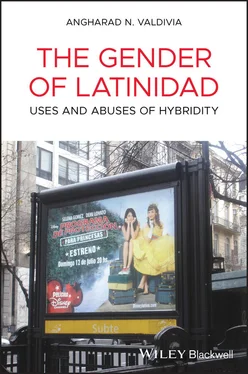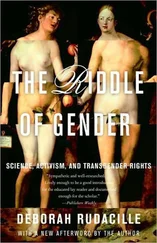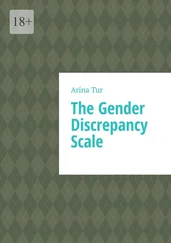Within US history, and really anywhere else in the world, ethnicization as a project has served not only to categorize but also to segregate. Government and marketing efforts to control and profit from this ethnic relationality coexist with ethnic populations' efforts to gain rights and access to democratic processes – including education – as well as their political and cultural representation, ranging from political elections – both as voters and as candidates – to mediated representations – both behind and in front of the camera. The slow quantitative increase in the representation of Latinas and the qualitative change of these representations of Latinidad bear witness to the resilience of ethnic narratives of purity and binary fantasies. Both of these tactics are so entrenched that they function as default. To try anything else means going against the stream. The force of this ideological marginalization and erasure ensures their survival, despite the fact that quite possibly it would be more profitable to leave them behind. The mainstream is not very open to change, even if it promises increased profit. Latinas provide a malleable signifier of difference that at once tames the unruliness of hybridity through desirable sexualized images and provides close to a tabula rasa of ethnic signification for government and business purposes. In the simplest of formulations, Latinas provide an in‐between space of representation for a nation that until recently thought of itself as black and white. The recurring and unavoidable reminders of a far more complex and violent history, culture, and population – that is, the inescapable heterogeneity within Latinidad and within the US population – renders such simplicity unstable and untenable. Yet, hybridity bites back. Returning the look or focus to the mainstream with the complexity of that in‐between space, Latinas talk and push back (Báez 2018). Ethnically diverse Latinas can use the foregrounding of ambiguity to complicate previously binary US national imaginary. Industry and audiences understand that ambiguity simultaneously displaces, and sometimes replaces, the darker, usually black, subject (see also Molina‐Guzmán 2005). Throughout the research on the subject, the attention to global circulation and hybridity has been constant. Latina/os come from everywhere and fan out everywhere – in unexpected paths. What are we to make of the Latin Americans who migrate to Europe – either Spain or the United Kingdom – and later come to the States as European citizens (Retis, 2014)? My ongoing interest in hybridity and mixed race, as a rejection of purity and an indicator or Latina/os and Latinidad, takes me back to the mainstream, a hybrid space that attempts to assert purity through contradiction and erasure – a process whose failure is yet another indication of the identity crisis facing the United States as a nation and transmitted globally through transnational conglomerate media industries.
The uses and abuses of representing ethnicities as hybrid have both potential for liberation and an expanded public sphere but also the danger of subsuming all difference into a flat ambiguous otherness for the sake of commodification and transnational profit. Therein lies the rub, in terms of production and activism. Producers within the mainstream and activists trying to make demands upon mainstream media industries engage in unequally empowered bargaining and negotiations. Demands for richer and more textured narratives are met with resistance and outright avoidance. Industry executives claim that the profit motive guides development, and as such it makes little sense to alienate a large segment of the audience. Even when production of a television show including a range of Latinas somehow comes to be, the perceived tensions between mainstream (read: white) and Latina (read: brown) audiences appear to producers as a liability rather than a possibility. Exploring the production of Devious Maids as a more Latina version of Desperate Housewives , Báez (2015) concluded: “Ultimately, in trying to simultaneously appeal to a broader female audience and a narrow Latina/o audience segment, Devious Maids illustrates the difficulties cable networks like Lifetime experience in trying to diversify programming that will attract highly segmented audiences, while also maintaining their larger audience base” (p. 54). Internal contradictions abound.
The long history of representations of Latina/os in the US mainstream reveals far more continuities than ruptures. Felix Gutiérrez (2012) summarizes the range of possibilities:
Greasy bandidos, fat mamacitas, romantic Latin lovers, lazy peons sleeping under sombreros, short‐tempered Mexican spitfires, violent revolutionaries, faithful servants, gang members, and sexy señoritas with low‐cut blouses and loose morals have long been staples of Latin images in fiction, films, and television. When seen on the screen or page, the stereotyped characters quickly trigger a picture in the heads of the audience of what the character is like and what role she or he will play as the plot unfolds.
(p. 100)
This neat summary of production leading to representations leading to audience reactions maps out the continuities. Yet, we also have some presence in the mainstream, which sometimes brings along ruptures. In the entertainment realm, we have the continuation of Jennifer Lopez as the reigning Latina mogul whose ethnic presence does not preclude her othering of other ethnics, such as a recent incident on The Voice with an Asian American contestant (Washington 2017a). As mentioned previously in this chapter, ethnicities between the white and black ends of the spectrum are positioned in uneasy relation to one another. In this particular case, Lopez deployed her agency and status as a successful mainstream Latina to pass judgment on Asian Americans striving for presence and success in the same mainstream. We have also witnessed the rise of Sofia Vergara, the breakout star from the ensemble‐cast mockumentary Modern Family . As the best‐paid television actress, Ms. Vergara represents the latest Latin bombshell to hit US airwaves. Former Disney and Barney girls Selena Gomez and Demi Lovato continue their music, acting, and branded‐products careers, with the ups and downs that follow young media celebrities. Gina Rodriguez became a breakout star through the aptly Latina‐entitled Jane the Virgin . While the title is cheeky, it does hook to the Roman Catholicism stereotypically attributed to Latina/o populations in the United States. Cameron Diaz, Christy Turlington, Salma Hayek, Eva Longoria, Eva Mendez, Michelle Rodriguez, Zoe Saldana, Sofia Carlson, and others all remain bankable mainstream figures. Notice that these spectacular Latinas represent the multiplicity within Latinidad. Cameron Diaz is a blonde and blue‐eyed Cuban American from San Diego whose Latinidad would go nearly unperceived were it not for her last name. Former supermodel Christy Turlington has used her Latinidad, as a Salvadorean American, almost as a way to stay in the limelight after aging out of her top‐model days. Salma Hayek will be more extensively discussed in Chapter 2, but suffice it to say that she is a first‐generation Mexican, of Hungarian and Spanish Jewish parents, who crossed over in the United States and now lives in France. Eva Longoria, Eva Mendez, and Sofia Carlson fit the bill as petite light‐brown Latinas. Michelle Rodriguez is Afro‐Latina, something she has said was a cause of conflict in her family, and has been typecast in a long career performing embodied and active Latina roles (Beltrán 2004). Zoe Saldana, also Afro‐Latina, has removed some of the Latinidad by taking the ñ out of her name (Molina‐Guzmán 2013b) and shortening it from Zoë Yadira Saldaña Nazario. She hit the big time through the Star Trek franchise, and has played a range of African American and ethnically ambiguous characters, gaining controversy through her casting as Nina Simone. All of these spectacular Latinas form part of the mainstream terrain. Yet, fully half do not fit the light‐brown ambiguous mold, and thus are seldom discussed as Latina. Nonetheless, when it suits the individual stars or when media companies find it useful to reach out to Latina/o or ethnic audiences, white Latinas will exhort their Latinidad. Every once in a while, Cameron Diaz will assert her Latinidad, such as when she and Jennifer Lopez shared the stage while presenting an award at the 2012 Oscars. That moment, when they posed with their backs to the cameras, simultaneously reiterated their common Latinidad and differentiated Diaz's whiteness from Lopez's more ethnic body. On the other hand, Longoria and Mendez are always already Latinas, regardless of the story or role in which they appear. Unambiguous white Latinas, such as Diaz and Turlington, have the luxury of passing as white and choosing to out their Latinidad when it suits them. Light‐brown Latinas play across the racial spectrum. In addition to Jennifer Lopez, Jessica Alba has proven so malleable that she has played characters from albino in the Fantastic Four (2009) to an African American in Honey (2003). The inescapably racialized Rodriguez and Saldana enjoy embodied careers, wherein they have to continuously prove their belonging within Latinidad and African American‐ness. Border crossings for these Afro‐hybrid Latinas are far more inspected than for the white and light‐brown ones. Clearly, Latina actors are useful to mainstream media industries for their malleability and the fact that they can displace other ethnicities.
Читать дальше












